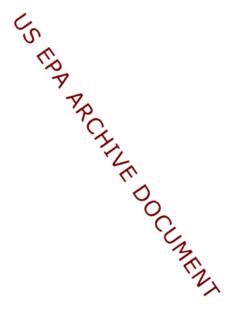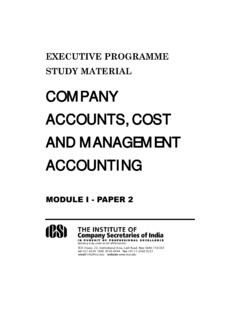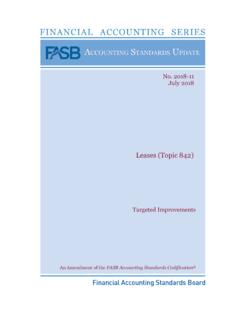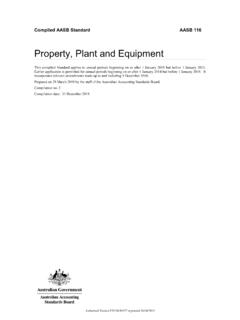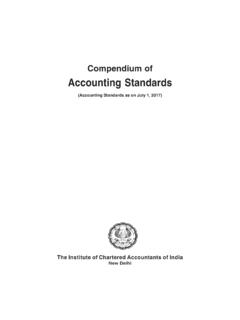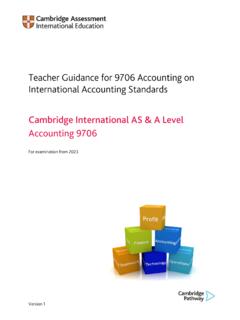Transcription of Cost Accounting Standards - CMS
1 cost Accounting StandardsCost Accounting StandardsLarry CatonAcquisition cost /Price Analyst2 Background Information1968 Congressional hearings raised concerns over the lack of cost control and consistency in Defense contract cost Accounting practices1970 Congress passed Public Law 91-379 which formed the cost Accounting Standards board (CASB), the CAS board functioned for a decade promulgating 19 Standards , and numerous interpretations1992 the cost Accounting Standards (CAS) was recodified into the Federal Acquisition Regulation (FAR) and made applicable to all negotiated Government contracts3 Purpose of CASCost Accounting Standards (CAS) are a set of Standards that are designed to achieve uniformity and consistency in cost Accounting practices. 4 Advantages of CASC onsistency ComparabilityMore accurate cost allocations Higher degree of reliance on Accounting systems which reduces risk of incorrect charging or misallocations5 Fundamental Difference Between CAS and FAR RegulationsCAS deals with the allocability of costFAR deals both with allocability and allowability of cost6 CAS Standards Implemented by the FAR cost PrinciplesCAS StandardFAR Reference CAS StandardFAR , (d) , ** , (a) , * (j)404** (m), * (j)405** , * (a) (e)415* (i) & (k) * (a) (a) & (m) (b) 409** , 420* (b) * These Standards are incorporated by reference under most circumstances.
2 ** These Standards are substantively duplicated by the cost Contracts are CAS Covered?Any negotiated government contract/subcontract for over $500,000 or more, as long as the Business Unit is currently performing a CAS covered contract/subcontract valued at $ million or Coverage and Disclosure Statement Determination9 Different Degree of CAS CoverageModified CAS CoverageCAS 401, 402, 405, 406 Fully CAS Coverage with a Disclosure StatementAll 19 Standards with a Disclosure Statement10 cost Accounting Standards401*Consistency in Estimating, Accumulating, and Reporting Costs402*Consistency in Allocating Costs Incurred for the Same Purpose403 Allocation of Home Office Expenses to Segments404 Capitalization of Tangible Assets405* Accounting for Unallowable Costs406* cost Accounting Period407 Use of Standard Costs for Direct Material and Direct Labor408 Accounting for Costs of Compensated Personal Absence409 Depreciation of Tangible Capital Assets410 Allocation of Business Unit General and Administrative Expenses to Final cost Objectives11 cost Accounting Standards411 Accounting for Acquisition Costs of Material412 Composition and Measurement of Pension Cost413 Adjustment and Allocation of Pension Cost414 cost of Money as an Element of the cost of Facilities Capital415 Accounting for the cost of Deferred Compensation416 Accounting for Insurance Costs 417 cost of Money as an Element
3 Of the cost of Capital Assets under Construction418 Allocation of Direct and Indirect Costs 419 Reserved420 Accounting for Independent Research and Development and Bidand Proposal Costs12 CAS Standards Focused on During this Training Session406* cost Accounting Period401*Consistency in Estimating, Accumulating, and Reporting Costs402*Consistency in Allocating Costs Incurred for the Same Purpose418 Allocation of Direct and Indirect Costs 410 Allocation of Business Unit General and Administrative Expenses to Final cost Objectives403 Allocation of Home Office Expenses to Segments404 Capitalization of Tangible Assets409 Depreciation of Tangible Capital Assets405* Accounting for Unallowable Costs420 Accounting for Independent Research and Development and Bidand Proposal Costs408 Accounting for Costs of Compensated Personal Absence13 Format of the CAS Standards20 Purpose30 Definitions40 Fundamental Requirement50 Techniques for Application60 Illustrations63 Effective Date14 CAS 406 cost Accounting PeriodCAS A contractor shall use a fiscal year defined in the standard to mean a 12 month period, 52 weeks, or 53 weeks as his cost Accounting period.
4 With the exception for changes in cost Accounting 401 Consistency in Estimating, Accumulating and Reporting CostsCAS Fundamental Accounting systems need to estimate and accumulate cost in the same manner. (This is both on the same contract and between contracts)However, contractors can accumulate cost in greater detail than they estimated and still be incompliance with they standard16 CAS Illustrations Practices Deemed to be ConsistentPractices used in estimating cost for estimates an average direct labor rate for manufacturing direct labor by labor category or function. estimates an average cost for minor standard hardware items, including nuts, bolts, washers, etc. Practiced used in accumulating and reporting cost of contract records manufacturing direct labor based on actual cost for each individual and collects such costs by labor category or function.
5 Records actual cost for minor standard hardware items based upon invoices or material transfer slips. 17 CAS Illustrations Practices that are not Deemed to be ConsistentPractices used in accumulating and reporting costs of contract performance accumulates total engineering labor in one undifferentiated records separately the actual cost of machining labor and material as direct costs, and factory overhead as indirect costs. Practices used for estimating costs for estimates engineering labor by cost function, , drafting, production engineering, estimates a since dollar amount for machining cost to cover labor, material and overhead. 18 CAS 402 Consistency in Allocating Costs Incurred for the Same PurposeCAS purpose of this standard is to require that each type of cost is allocated only once and on only one basis to any contract or other cost 402 Consistency in Allocating Costs Incurred for the Same PurposeCAS Definitions.
6 (3) Direct cost means any cost which is identified specifically with a particular final cost objective. Direct costs are not limited to items which are incorporated in the end product as material or labor. Costs identified specifically with a contract are direct costs of that contract. All costs identified specifically with other final cost objectives of the contractor are direct costs of those cost 402 Consistency in Allocating Costs Incurred for the Same PurposeCAS Definitions.(4) Final cost objective means a cost objective which has allocated to it both direct and indirect costs, and in the contractor s accumulation, system, is one of the final accumulation 402 Consistency in Allocating Costs Incurred for the Same PurposeCAS Definitions.(6) Indirect cost pool means a group of incurred costs identified with two or more cost objectives but not specifically identified with any final cost 402 Consistency in Allocating Costs Incurred for the Same PurposeCAS Fundamental costs incurred for the same purpose, in like circumstances, are either direct costs only or indirect costs only with respect to final cost objectives.
7 No final cost objective shall have allocated to it as an indirect cost any cost , if other costs incurred for the same purpose, in like circumstances, have been included as a direct cost of that or any other final cost 402 Consistency in Allocating Costs Incurred for the Same PurposeCAS Fundamental , no final cost objective shall have allocated to it as a direct cost any cost , if other costs incurred for the same purpose, in like circumstances, have been included in any indirect cost pool to be allocated to that or any other final cost 402 Consistency in Allocating Costs Incurred for the Same PurposeCAS counting occurs most commonly when cost items are allocated directly to a cost objective without eliminating like cost items from indirect cost pools which are allocated to that cost 402 Consistency in Allocating Costs Incurred for the Same PurposeCAS Techniques for application.
8 (e) Any direct cost of minor dollar amount may be treated as an indirect cost for reasons of practicality where the Accounting treatment for such cost is consistently applied to all final cost objectives, provided that such treatment produces results which are substantially the same as the results would have been obtained if such cost had been treated as a direct cost . 26 CAS IllustrationsContractor normally allocates all travel as an indirect cost andpreviously disclosed this Accounting practice to the Government. For purposes of a new proposal, contractor intends to allocate the travel costs of personnel whose time is accounted for as direct labor directly to the contract. Since travel costs of personnel whose time is accounted for as direct labor working on other contracts are costs which are incurred for the same purpose, these costs may no longer be included with indirect cost pools for purposes of allocation to any covered Government contract.
9 Contractor s Disclosure Statement must be amended for the proposed changes in Accounting practices. 27 CAS IllustrationsContractor normally allocates special tooling costs directly to contracts. The costs of general purpose tooling are normally included in the indirect cost pool which is allocated to contracts. Both of these Accounting practices were previously disclosed to the Government. Since both types of costs involved were not incurred for the same purpose in accordance with the criteria set forth in the contractor s Disclosure Statement, the allocation of general purpose tooling costs from the indirect cost pool to the contract, in addition to the directly allocated special tooling costs is not considered a violation of the standard. 28 CAS 410 Allocation of Business Unit G&A Expenses to Final cost ObjectivesCAS purpose of this cost Accounting Standard is to provide criteria for the allocation of business unit general and administrative (G&A) expense to business unit final cost objectives based on their beneficial or causal 410 Allocation of Business Unit G&A Expenses to Final cost ObjectivesCAS Definitions.
10 (2) Business Unit means any segment of an organization, or an entire business organization which is not divided into segments.(3) cost input means the cost , except G&A expense, which for contract costing purposes is allocable to the production of goods and services during a cost Accounting 410 Allocation of Business Unit G&A Expenses to Final cost ObjectivesCAS Definitions.(6) General and Administrative (G&A) expense means any management, financial, and other expense which is incurred by or allocated to a business unit and which is for the general management and administration of the business unit as a 410 Allocation of Business Unit G&A Expenses to Final cost Objectives(7) Segment means one of two or more divisions, product departments, plants, or other subdivisions of an organization reporting directly to a home office, usually identified with responsibility for profit and/or producing a product or service.











